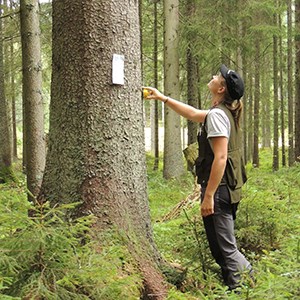Contact
 Cornelia Roberge, Program manager Swedish NFI
Cornelia Roberge, Program manager Swedish NFI
The Swedish National Forest Inventory, SLU
cornelia.roberge@slu.se, +46 (0)90-786 8275

The Swedish National Forest Inventory has the task of describing the state and changes in Sweden's forests. The information collected is used, for example, as a basis for forestry, energy and environmental policy in Sweden. Data from the Swedish National Forest Inventory is part of Sweden's official statistics.
At the heart of the Swedish National Forest Inventory is the annual inventory which is undertaken by ca 50 field workers during the snow free period. Every year an inventory is carried out on ca 12 000 sample plots with measurements collected from ca 95 000 trees and large range of other variables describing the stand, site and history of the sample plot.
Data collection has come a long way since the first Inventory in 1923 where data was recorded on handwritten field forms. In the 1970's punch cards were introduced and from 1983 handheld field computers have been used. Today each field crew works with two Allegro hand held computers which have wireless syncronisation and backup in the field. Data is stored in a database within the handheld computers and then sent back to the office in Umeå where data from all the field crews are stored in an annual database. After quality control the annual database is transfered over to the analysis database where all data collected since 1983 is stored.
After the field data has been collected they are subjected to comprehesive quality controls and secondary variables are calculated before the data is stored and ready for final analysis and publication.
Quality control
After the data has been collected in the field it is subjected to a battery of tests and quality controls. Quality control tests are undertaken in the field in the form of probability tests direct in the hand held computers, this gives the field crews the opportunity of correcting the data directly. Both during and after the field season special control crews undertake a full re-inventory of selected sample tracts to double check the collected data. Finally a second battery of probaility tests are undertaken at the field office before the data is transfered to it's final storage destination.
Annual ring measurements
For all sample trees an age is judged in the field. On top of this bore cores are collected and sent to the field office for analysis. Annual growth is measured on all the bore cores using a high precision instrument. These measurements are stored in a database and this information forms the base of growth estimates for the Swedish forests.
Secondary variables
When the field data has been quality controlled a large number of secondary variables are calculated. In order to present statistics about standing volume and annual growth the Swedish National Forest Inventroy calculates both volume and growth for the trees within the random sample covered in the inventory. Volume is calulated using the correlation between diameter and height and volume. Growth is calculated based upon the annaul ring measrement data. The trees' biomass is also calculated.
Analysis and presentation
The Swedish National Forest Inventory publishes data in a wide range of forms ranging from key values verbally via telephone to comprehensive anlysis comprising serveral years work. Each year a range of fundamental forest statistics are published in Skogsdata in the form of mean values for the last five years.
 Cornelia Roberge, Program manager Swedish NFI
Cornelia Roberge, Program manager Swedish NFI
The Swedish National Forest Inventory, SLU
cornelia.roberge@slu.se, +46 (0)90-786 8275